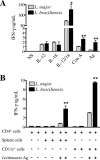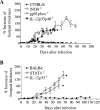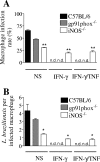Cytokines, signaling pathways, and effector molecules required for the control of Leishmania (Viannia) braziliensis in mice
- PMID: 17517868
- PMCID: PMC1951993
- DOI: 10.1128/IAI.01335-06
Cytokines, signaling pathways, and effector molecules required for the control of Leishmania (Viannia) braziliensis in mice
Abstract
Cutaneous leishmaniasis is caused by protozoan parasites of the genus Leishmania. The mechanisms of pathogen control have been established primarily in the mouse model of Leishmania major infection, but they might not hold true for other Leishmania species associated with cutaneous disease. Here, we analyzed the role of cytokines, signaling components, and effector molecules in the control of New World cutaneous leishmaniasis due to L. braziliensis. Unlike L. major, L. braziliensis caused small, nonulcerative, and self-healing skin swelling in C57BL/6 mice, as well as BALB/c mice. In contrast to the results obtained for L. mexicana, mice deficient for interleukin-12 or its key signaling molecule, signal transducer and activator of transcription 4, rapidly succumbed to severe visceral leishmaniasis. Infection of tumor necrosis factor knockout mice with L. braziliensis led to progressive, nonhealing skin lesions with erosions and hemorrhagic ulcerations, but in contrast to the results with L. major, only 20 to 30% of the mice developed fatal visceral disease. As seen with L. major, mice with a deleted inducible nitric oxide synthase gene (iNOS(-/-)) were unable to contain L. braziliensis in the skin, whereas the control of the parasite in the spleen remained unimpaired. Unlike what happens in L. major infections, NADPH oxidase had no impact on the course of disease in L. braziliensis-infected mice. These results not only define essential components of a protective immune response to L. braziliensis but also illustrate that the requirements for the control of cutaneous leishmaniasis vary between different parasite species.
Figures









Similar articles
-
Testing of four Leishmania vaccine candidates in a mouse model of infection with Leishmania (Viannia) braziliensis, the main causative agent of cutaneous leishmaniasis in the New World.Clin Vaccine Immunol. 2007 Sep;14(9):1173-81. doi: 10.1128/CVI.00060-07. Epub 2007 Jul 11. Clin Vaccine Immunol. 2007. PMID: 17626159 Free PMC article.
-
Control of Leishmania major in the absence of Tyk2 kinase.Eur J Immunol. 2004 Feb;34(2):519-29. doi: 10.1002/eji.200324465. Eur J Immunol. 2004. PMID: 14768057
-
S-nitrosoglutathione (GSNO) is cytotoxic to intracellular amastigotes and promotes healing of topically treated Leishmania major or Leishmania braziliensis skin lesions.J Antimicrob Chemother. 2013 Nov;68(11):2561-8. doi: 10.1093/jac/dkt210. Epub 2013 Jun 19. J Antimicrob Chemother. 2013. PMID: 23788476
-
Immunopathogenic competences of Leishmania (V.) braziliensis and L. (L.) amazonensis in American cutaneous leishmaniasis.Parasite Immunol. 2009 Aug;31(8):423-31. doi: 10.1111/j.1365-3024.2009.01116.x. Parasite Immunol. 2009. PMID: 19646206 Review.
-
The innate immune response against Leishmania parasites.Immunobiology. 2008;213(3-4):377-87. doi: 10.1016/j.imbio.2007.12.005. Epub 2008 Mar 4. Immunobiology. 2008. PMID: 18406382 Review.
Cited by
-
Human classical monocytes control the intracellular stage of Leishmania braziliensis by reactive oxygen species.J Infect Dis. 2014 Apr 15;209(8):1288-96. doi: 10.1093/infdis/jiu013. Epub 2014 Jan 7. J Infect Dis. 2014. PMID: 24403561 Free PMC article.
-
Identification and Biological Characterization of Leishmania (Viannia) guyanensis Isolated from a Patient with Tegumentary Leishmaniasis in Goiás, a Nonendemic Area for This Species in Brazil.Biomed Res Int. 2015;2015:350764. doi: 10.1155/2015/350764. Epub 2015 Oct 25. Biomed Res Int. 2015. PMID: 26583102 Free PMC article.
-
In Leishmania major, the Homolog of the Oncogene PES1 May Play a Critical Role in Parasite Infectivity.Int J Mol Sci. 2021 Nov 22;22(22):12592. doi: 10.3390/ijms222212592. Int J Mol Sci. 2021. PMID: 34830469 Free PMC article.
-
Polymerase chain reaction detection and inducible nitric-oxide synthase expression of Leishmania major in mice inoculated by two different routes.Trop Parasitol. 2016 Jan-Jun;6(1):42-50. doi: 10.4103/2229-5070.175088. Trop Parasitol. 2016. PMID: 26998433 Free PMC article.
-
Leishmania RNA virus: when the host pays the toll.Front Cell Infect Microbiol. 2012 Jul 12;2:99. doi: 10.3389/fcimb.2012.00099. eCollection 2012. Front Cell Infect Microbiol. 2012. PMID: 22919688 Free PMC article. Review.
References
-
- Amato, V. S., H. F. Andrade, V. A. Neto, and M. I. S. Duarte. 2003. Persistence of tumor necrosis factor-α in situ after lesion healing in mucosal leishmaniasis. Am. J. Trop. Med. Hyg. 68:527-528. - PubMed
-
- Anderson, C. F., S. Mendez, and D. L. Sacks. 2005. Nonhealing infection despite Th1 polarization produced by a strain of Leishmania major in C57BL/6 mice. J. Immunol. 174:2934-2941. - PubMed
-
- Barral, A., J. Guerreiro, G. Bomfim, D. Correia, M. Barral-Netto, and E. M. Carvalho. 1995. Lymphadenopathy as the first sign of human cutaneous infection by Leishmania braziliensis. Am. J. Trop. Med. Hyg. 53:256-259. - PubMed
-
- Belosevic, M., D. S. Finbloom, P. H. van der Meide, M. V. Slayter, and C. A. Nacy. 1989. Administration of monoclonal anti-IFN-γ antibodies in vivo abrogates natural resistance of C3H/HeN mice to infection with Leishmania major. J. Immunol. 143:266-274. - PubMed
Publication types
MeSH terms
Substances
LinkOut - more resources
Full Text Sources
Molecular Biology Databases
Research Materials

